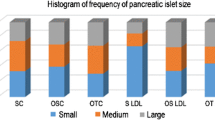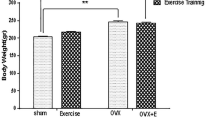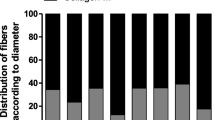Abstract
To explore the effects of physical exercise on the liver of animals in menopause, we analyzed the histomorphometric parameters of the hepatic tissue in ovariectomized and dyslipidemic female mice. The animals were distributed in six groups (n = 5): sedentary control (SC), sedentary ovariectomized control (SOC), trained ovariectomized control (TOC), sedentary LDL knockout (LDL-S), sedentary ovariectomized LDL knockout (LDL-SO), and trained ovariectomized LDL knockout (LDL-TO). At the end of the experiment, the liver and the visceral adipose tissue (VAT) of animals were removed for morphometric and stereological studies. In the LDL-S and LDL-SO animals, both sedentary, results showed reduction in the area (µm2) and major and minor diameters (µm) of hepatocytes and reduction in the portions of large hepatocytes, and increase in the percentage of Kupffer cells. The trained group showed a tendency of increase in the area and diameter and in the percentage of hepatocytes, as well significant reduction in the percentage of Kupffer cells and interstitial tissue. We suggested that training can prevent cell and tissue damage caused by the process of increase in hepatic fat, lipoperoxidation, and tissue inflammation in animals with privation of estrogen and dyslipidemia, apparently reflecting a better metabolic response of the hepatic tissue in organisms undergoing training.



Similar content being viewed by others
References
Lavoie JM, Pighon A (2012) NAFLD, estrogens, and physical exercise: the animal model. J Nutr Metab 2012(914938):10
Novelli EL, Diniz YS, Galhardi CM, Ebaid GM, Rodrigues HG, Mani F et al (2007) Anthropometrical parameters and markers of obesity in rats. Lab Anim 41(1):111–119
Sjogren K, Hellberg N, Bohlooly YM, Savendahl L, Johansson MS, Berglindh T et al (2001) Body fat content can be predicted in vivo in mice using a modified dual-energy X-ray absorptiometry technique. J Nutr 131(11):2963–2966
Shi H, Strader AD, Woods SC, Seeley RJ (2007) The effect of fat removal on glucose tolerance is depot specific in male and female mice. Am J Physiol Endocrinol Metab 293(4):24
Koek GH, Liedorp PR, Bast A (2011) The role of oxidative stress in non-alcoholic steatohepatitis. Clin Chim Acta 412(15–16):1297–1305
Cardoso JA, Toscano AE, Tashiro T, de Carvalho CA, de Moraes SR (2006) Morphometry of human myocardium in senile individuals. Arq Bras Cardiol 86(5):374–377
Coylewright M, Reckelhoff JF, Ouyang P (2008) Menopause and hypertension: an age-old debate. Hypertension 51(4):952–959
Lamas O, Martinez JA, Marti A (2004 Jul) Energy restriction restores the impaired immune response in overweight (cafeteria) rats. J Nutr Biochem 15(7):418–425
de Lima C, Alves LE, Iagher F, Machado AF, Bonatto SJ, Kuczera D et al (2008) Anaerobic exercise reduces tumor growth, cancer cachexia and increases macrophage and lymphocyte response in Walker 256 tumor-bearing rats. Eur J Appl Physiol 104(6):957–964
Jarrar BM, Taib NT (2012) Histological and histochemical alterations in the liver induced by lead chronic toxicity. Saudi J Biol Sci 19(2):203–210
Guzman G, Chennuri R, Voros A, Boumendjel R, Locante A, Patel R et al (2011) Nucleometric study of anisonucleosis, diabetes and oxidative damage in liver biopsies of orthotopic liver transplant recipients with chronic hepatitis C virus infection. Pathol Oncol Res 17(2):191–199
Leite RD, Prestes J, Bernardes CF, Shiguemoto GE, Pereira GB, Duarte JO et al (2009) Effects of ovariectomy and resistance training on lipid content in skeletal muscle, liver, and heart; fat depots; and lipid profile. Appl Physiol Nutr Metab 34(6):1079–1086
Berglund ED, Lustig DG, Baheza RA, Hasenour CM, Lee-Young RS, Donahue EP et al (2011) Hepatic glucagon action is essential for exercise-induced reversal of mouse fatty liver. Diabetes 60(11):2720–2729
Marcondes FK, Bianchi FJ, Tanno AP (2002) Determination of the estrous cycle phases of rats: some helpful considerations. Braz J Biol 62(4A):609–614
Mandarim-de-Lacerda CA, Pessanha MG (1995) Stereology of the myocardium in embryos, fetuses and neonates of the rat. Acta Anat 154(4):261–266
Cui A, Hu Z, Han Y, Yang Y, Li Y (2017) Optimized analysis of in vivo and in vitro hepatic steatosis. J Vis Exp. https://doi.org/10.3791/55178
Zhao YY, Yang R, Xiao M, Guan MJ, Zhao N, Zeng T (2017) Kupffer cells activation promoted binge drinking induced fatty liver by activating lipolysis in white adipose tissues. Toxicology 390:53–60
Veloso AGB, Lima NEA, de Marco Ornelas E, Cardoso CG, Marques MR, da Costa Aguiar Alves Reis B, Fonseca FLA, Maifrino LBM (2018) Effects of moderate exercise on biochemical, morphological, and physiological parameters of the pancreas of female mice with estrogen deprivation and dyslipidemia. Med Mol Morphol 51:118–127
Marchon C, de Marco Ornelas E, da Silva Viegas KA, Lacchini S, de Souza RR, Fonseca FL et al (2015) Effects of moderate exercise on the biochemical, physiological, morphological and functional parameters of the aorta in the presence of estrogen deprivation and dyslipidemia: an experimental model. Cell Physiol Biochem 35(1):397–405
Kim MH, Kim EJ, Choi YY, Hong J, Yang WM (2017) Lycium Chinense improves post-menopausal obesity via regulation of PPAR-γ and estrogen receptor-α/β expressions. Am J Chin Med 45(2):269–282
Tarantino G, Pizza G, Colao A, Pasanisi F, Conca P, Colicchio P et al (2009) Hepatic steatosis in overweight/obese females: new screening method for those at risk. World J Gastroenterol 15(45):5693–5699
18 Fabbrini E, Sullivan S, Klein S (2010) Obesity and nonalcoholic fatty liver disease: biochemical, metabolic, and clinical implications. Hepatology 51(2):679–689
Kolaja KL, Klaunig JE (1997) Vitamin E modulation of hepatic focal lesion growth in mice. Toxicol Appl Pharmacol 143(2):380–387
Kenneally S, Sier JH, Moore JB (2017) Efficacy of dietary and physical activity intervention in non-alcoholic fatty liver disease: a systematic review. BMJ Open Gastroenterol 4(1):000139
21 Ryan AS, Pratley RE, Goldberg AP, Elahi D (1996) Resistive training increases insulin action in postmenopausal women. J Gerontol A Biol Sci Med Sci 51(5):M199–M205
Suzuki A, McCall S, Choi SS, Sicklick JK, Huang J, Qi Y, Zdanowicz M, Camp T, Li YX, Diehl AM (2006) Interleukin-15 increases hepatic regenerative activity. J Hepatol 45(3):410–418
Funke A, Schreurs M, Aparicio-Vergara M, Sheedfar F, Gruben N, Kloosterhuis NJ, Shiri-Sverdlov R, Groen AK, van de Sluis B, Hofker MH, Koonen DP (2014) Cholesterol-induced hepatic inflammation does not contribute to the development of insulin resistance in male LDL receptor knockout mice. Atherosclerosis 232(2):390–396
Ryan AS, Pratley RE, Elahi D, Goldberg AP (1985) Resistive training increases fat-free mass and maintains RMR despite weight loss in postmenopausal women. J Appl Physiol 79(3):818–823
Brochu M, Malita MF, Messier V, Doucet E, Strychar I, Lavoie JM et al (2009) Resistance training does not contribute to improving the metabolic profile after a 6-month weight loss program in overweight and obese postmenopausal women. J Clin Endocrinol Metab 94(9):3226–3233
Hansen D, Dendale P, Berger J, van Loon LJ, Meeusen R (2007) The effects of exercise training on fat-mass loss in obese patients during energy intake restriction. Sports Med 37(1):31–46
Author information
Authors and Affiliations
Corresponding author
Ethics declarations
Conflict of interest
The authors declare no conflict of interest.
Rights and permissions
About this article
Cite this article
Rodrigues, F.M., Adélio, J.I., Santana, V.O. et al. Physical exercise alters hepatic morphology of low-density lipoprotein receptor knockout ovariectomized mice. Med Mol Morphol 52, 15–22 (2019). https://doi.org/10.1007/s00795-018-0198-7
Received:
Accepted:
Published:
Issue Date:
DOI: https://doi.org/10.1007/s00795-018-0198-7




